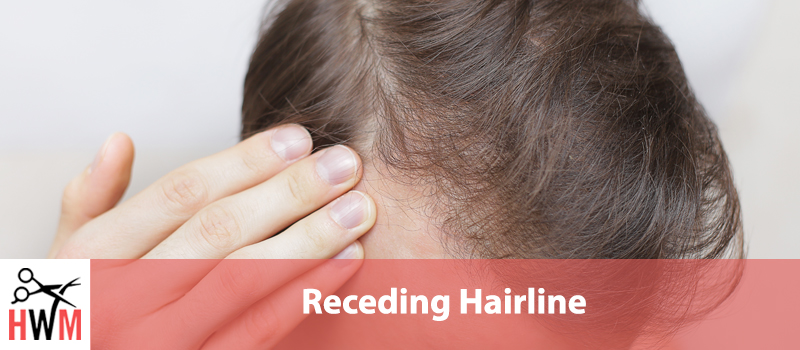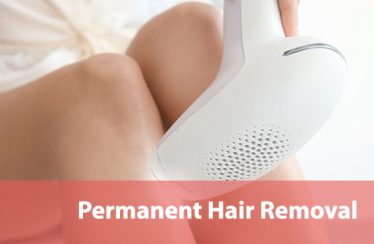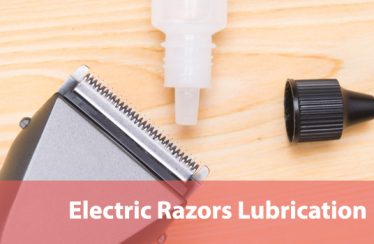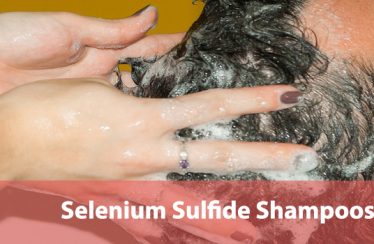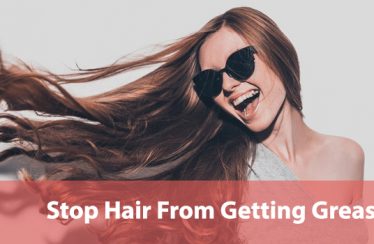Receding hairlines are one of the most common forms of hair loss, especially for men. Sometimes it’s obvious, your forehead turns into a ten head over time. Even if your hairline is pulling back more subtly, giving you a widow’s peak or a mild thin spot, you probably want to stop the process in its tracks.
Our goal is to empower you to identify the early signs of a receding hairline (it’s common for men to start noticing a receding hairline as early as your 20’s!) and identify risk factors for this type of hair loss.
We’ll also talk about treatment options and some things you can do at home to protect and preserve your hair.
- First Signs of a Receding Hairline
- Risk Factors for Hair Loss and Receding Hairlines
- The Role of DHT
- Treatment Options
- Taking Control, Hair Loss Treatment Options at Home
First Signs of a Receding Hairline
Hair tends to start receding just above your temples. But, by the time you have visible hair loss, in the form of a widow’s peak or thin see-through hair at your temples, you’ve already lost quite a bit of hair in those areas.
The first sign of hair loss is usually noticing more hair in your brush or comb, on your pillow, and going down the shower drain.
Some hair loss and some loose strands of hair in these places is totally normal. You naturally shed 50-100 individual hairs every day as a part of the natural growth cycle in your hair follicles. You might lose a little more hair if the strand itself is damaged or dry since the strands can break.
So, instead of watching for the hair itself, watch for changes in how much hair is lost during that natural process. If you’re losing more hair than your growing, or you notice that your hair feels thinner (you can often feel it combing your fingers through your hair before you can see it), that’s when you should start watching for hair loss.
Receding hairlines are also different from diffuse hair loss. Diffuse hair loss is thinning throughout your head. It’s usually less noticeable than a receding hairline unless it’s severe. Your hairline can recede as a part of diffuse hair loss, but usually only in the late stages of loss, or because you’re getting multiple forms of hair loss at once.
You should remember that 80% of white men will have some form of receding hairline by the time they are 80. Some of Hollywood’s biggest and most attractive actors have hair loss, we’re looking at you Jude Law, so don’t panic if you notice a little more space on your forehead.
Risk Factors for Hair Loss and Receding Hairlines
Of course, there are some risk factors for a receding hairline, just like any other medical condition. Some of these factors aren’t in your control, but others are. Knowing which factors you’re dealing with can help you find effective treatment options.
Age
The biggest single risk factor for hair loss is age. Everyone and we do mean everyone, not just men, experiences some hair loss as they get older. This isn’t abnormal, and in many cases isn’t even considered true hair loss. It’s the result of changes to your hair follicles and skin and can be mild and diffuse enough that you don’t notice.
But as you get older, you’re also more likely to develop a noticeable form of hair loss. Receding hairlines tend to be strongly connected to age.
They aren’t very predictable, however. You might start to develop a receding hairline in your 20’s, but keep a mostly full head of hair with a mild widow’s peak for the rest of your life. Alternatively, you might keep your hair well into your 40’s and 50’s only to develop a rapidly receding hairline and lose most of your hair inside a few years’ time.
The only decent predictor is looking at family members to see when and if they started to develop a receding hairline. Your relatives are also a decent indication of how severe you can expect your receding hairline to be.
Pay special attention to your mother’s male relatives, male pattern baldness is transmitted on the X chromosome. You get it from your mom. If your mom’s brothers all have hair loss, chances are pretty good that you will too.
However, it’s also a recessive gene, so unless your mom also has hair loss, you might get lucky and get a good copy of the genes involved. If your mom has significant hair loss as well, chances are she has two x chromosomes with the genes that cause hair loss, and you’ll probably get it too.
Hormone Changes
Hormone changes go along with aging, so it should be no surprise that hormonal shifts affect your hair. It’s worth noting separately, however, since a lot of factors can change your body’s hormone balance.
Some medical conditions, like hypothyroidism, are connected to hormone changes and hair loss. If your hair loss comes on suddenly it’s worth a trip to the doctor to get tested for some of these common conditions.
Treating the condition can also help to restore your lost hair.
You can also see hormonal changes as a result of taking certain medications and supplements, or even thanks to diet and lifestyle changes.
For instance, soy is known to increase the amount of estrogen and similar hormones in the body, so drinking a lot of soy milk and eating a ton of tofu might change your body’s chemistry in significant ways.
Eating meat and dairy products from animals that have been treated with hormones can also cause hormone changes in your body.
Family History
We already mentioned that a family history of hair loss and receding hairlines, primarily in your mother’s family, can be a risk factor for your own hair loss.
Beyond genetic causes of hair loss, other medical conditions that cause hair loss can also be passed down. Prostate problems, low testosterone, and other conditions might come from other parts of your family and still cause a receding hairline if you get the same condition.
If you choose to go to a dermatologist or doctor to look at hair loss treatment options, you should put together a family history before the appointment. Be as complete as you can, even if you’re only noting which relatives have hair loss.
Your doctor will use the information to help target their testing and treatments toward the most likely causes of your hair loss, in addition to examining your hair and scalp to look for other causes.
Some Medications
We can’t provide a comprehensive list of all the medications that might cause or contribute to your receding hairline. If you’re worried about a medication, ask your doctor or pharmacist. They should be able to provide a list of known interactions and side effects, even if they don’t know for sure one way or another.
You can also check online lists, like this one from Healthline, or look up individual drug information factsheets from the US National Library of Medicine and the US National Institute for Health.
High Stress
High stress can also cause hair loss. Usually, this isn’t a good predictor for receding hairlines so much as for diffuse hair loss.
Fortunately, whether it’s affecting your hairline or all your hair, stress-related hair loss, or effluvium, is usually temporary. Your hair will grow back when your stress level calms down.
Illness
It shouldn’t be a surprise that illness can increase the severity of a receding hairline. If you experience a period of hair loss in conjunction with getting sick, even if it was just a severe cold, don’t worry.
Your hair will likely come back once you’re feeling better.
Just remember that it can take as much as six months for individual hair follicles to start growing a new strand of hair. So, while your hair will come back, you may have to wait a little while to see it.
Lifestyle Choices
Lastly, your hair is affected by the choices you make and the things you put in your body. If you are living a beer and frozen TV dinner lifestyle, chances are your hair will reflect that.
Because hair isn’t a critical feature of our bodies, its benefits are small from a survival standpoint, it’s one of the first parts of your body that will show stress from poor nutrition and substance use.
Hair also reacts to smoking. Cigarettes contain main ingredients that can slow and halt your hair growth. But almost anything you smoke will affect your hair in some way.
Those effects will be more pronounced the longer you smoke and the older you get.
Your scalp is also very dependent on good circulation for good hair growth. Exercise and heart health are important in maintaining a healthy head of hair. If your blood pressure is too high, or too low, it will affect your hair. If your O2 count is low, it will affect your hair.
Exercise combined with a good diet is the best way to make sure your whole body, including your hairline, is getting the nutrients and oxygen it needs.
If you’re concerned about nutrition, you can also add a multivitamin or a hair skin and nail vitamin to boost the most important nutrients. Don’t go crazy with the supplements, though, many of those essential vitamins and nutrients become toxic if you take too much.
The Role of DHT
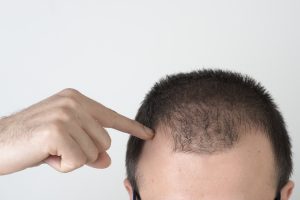
You’re probably wondering what in the world DHT is, and how it affects you. DHT is short for dihydrotestosterone, which is once of several naturally occurring forms of testosterone in your body.
How DHT functions is not entirely understood, but we do know that it has major impacts on hair growth throughout your body. Specifically, DHT encourages facial hair and body hair to grow in thicker and faster.
Oddly enough, DHT has the opposite effect on the hair on your head. Too much DHT bonding with the hair follicles in your scalp will shut those follicles down.
Too much DHT is one of the most common causes of a receding hairline. It’s associated with most of the common forms of male pattern baldness. It’s also somewhat connected with aging, and you’re likely to develop more DHT as you get older.
Reducing DHT, either through medication, lifestyle change, or topical treatments, is key to long-term hair maintenance and growth. We’ll talk about some options in the next two sections.
Treatment Options
Now that we’ve talked about the causes and risk factors that lead to receding hairlines, it’s time to talk about how you can treat your receding hairline. Most of what we’re going to discuss in this section requires talking to a doctor or dermatologist about your hair loss, except for using Rogaine.
If you’re looking for options that don’t require doctor’s appointments, a prescription, or medical procedures, skip to the next section.
Finasteride
Finasteride is a prescription hair loss treatment. It’s sold under the name Propecia. Finasteride is FDA approved and has shown significant results in treating and preventing hair loss.
Its main mechanism is controlling the DHT levels in your body. However, you do need a prescription, and it seems to work best combined with other topical hair treatments.
Rogaine
Rogaine, the brand name minoxidil formulation, is another FDA approved treatment for hair loss. It’s a topical treatment, and you need to apply it once or twice daily to see good results.
Rogaine shows decent results growing lost hair back, but tends to work best preserving your existing hair and preventing future hair loss.
It’s not a cure, you need to keep using Rogaine for however long you want to keep your hair. You won’t necessarily lose more hair when you quit using Rogaine, but you will lose all the hair Rogaine helped you keep or grow back.
Its most common side effect is scalp irritation, but that’s usually minimal and can decrease over time.
Hair Transplants
Another option for more permanent hair loss treatment is to get a hair transplant. Hair transplants use your hair, and you can usually go back to work and other normal activities a couple of days after the operation.
There are two main ways to ‘harvest’ hair follicles for the transplant. There’s the old-fashioned method, where they’d lift a patch of skin from the back of your head, somewhere your existing hair would easily cover, and then use that skin to create hair follicle ‘plugs’ to transplant into the thinning areas.
The other method, which is increasing in popularity and use, is to shave a section of hair and selectively pull individual hair follicles for transplant.
Both pulling individual hair follicles and transplanting them elsewhere irritates the surrounding skin on your scalp.
Not every follicle transplanted will be successful, but typically more than enough follicles go on to produce healthy new hair to improve the appearance of your hair.
Depending on the method, and how much scar tissue develops, you may also see hair re-growth in the donor area of your scalp.
Laser Therapy
Another option, and one that is considered less invasive than a hair transplant is using laser therapy to improve hair growth and density.
This works by stimulating the skin cells in your scalp, encouraging circulation and growth.
Laser is generally effective, although it works better early in hair loss than after your hair loss has become severe.
It can also take several treatment sessions for you to see results, and you will likely need to go back for occasional maintenance treatments to prevent your hair loss from returning.
Corticosteroids
This option is usually only done in a doctor or dermatologist’s office. They’ll examine your scalp carefully to see if corticosteroids might be a good treatment option for your specific type of hair loss.
Corticosteroids are useful when swelling, like from stress, an immune disorder, or other imbalances in your skin has started to block and interfere with the function of your hair follicles.
The corticosteroids are injected under the skin in the affected areas and provide long-term relief from swelling, which then helps to restore your follicles to normal function.
However, if corticosteroids are necessary, you’ll likely need to come back for regular treatments to maintain your results. They can also have other side effects, so you should talk with your doctor about what to expect and what the side effects might be before you decide to move ahead with this treatment.
Taking Control, Hair Loss Treatment Options at Home
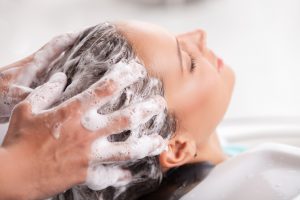
Of course, medical intervention isn’t right for everyone. Whether it’s personal preference, finances, or some other combination of factors, you may want to see if you can treat your receding hairline on your own before making the trip to a doctor.
These options can all be done at home, although they aren’t likely to be as effective as FDA approved medical treatments performed by a doctor.
Just like traditional medical treatments, your success depends on how early you intervene in your hair loss, and how consistent you are about treating the issue.
Hair Loss Shampoo / Conditioner
Hair loss shampoos and conditioners are often used in conjunction with Finasteride and Minoxidil treatments, and there have been plenty of studies showing that hair loss and moisturizing shampoos can increase the effectiveness of both products.
There have been fewer studies done on hair loss shampoo and conditioner by itself, although the available studies all show less significant results than Finasteride and Minoxidil products.
That said, hair loss shampoo is still a good first step to preserve your hairline. Avoid parabens, sulfates, and high alcohol content in your shampoo. You should also avoid clarifying shampoo.
Check the bottle and see if it mentions fighting DHT. Topical DHT treatments are effective so that’s a good sign that the shampoo is going to do what you want it to.
Peppermint and Lavender Essential Oils
We separated these two from the other essential oils on this list because some science has been done on both.
The studies in question are rat and mouse studies, so take the results with a grain of salt, but both peppermint essential oil and lavender essential oil have been shown to be similarly effective to Minoxidil treatment for hair growth in rats and mice.
Essential oils should be diluted in a carrier oil, like olive oil or coconut oil. You can also add them to your shampoo if you prefer.
Like minoxidil, essential oil treatments need to be used regularly to be effective.
Tea Tree, Rosemary, and Eucalyptus Essential Oils
Unlike peppermint and lavender essential oils, tea tree, rosemary, and eucalyptus are all anecdotally great treatments for hair loss and breakage, but they have not been evaluated by the scientific community to verify those claims.
All three, in theory, work much like peppermint and lavender. The oils are thought to increase circulation in your scalp, improving skin and hair follicle health.
Like all essential oils, they should be diluted into a carrier oil to avoid irritating your skin.
Hairstyle Options
If you tend to rock an updo hairstyle, like a ponytail or yes, even a man bun, that can cause a receding hairline as well. Traction alopecia is the result of tugging on your hair too much or for too long.
Even if that isn’t the main cause of your hair loss, it’s a good idea to give your hair a break from high or tight hairstyles for a few weeks and see if that slows or stops your hairline from receding. You can also consult with a dermatologist about hairstyle options that are less stressful on your hair.
Hairstylists and barbers can also make hairstyle recommendations that will help you keep your hair longer.
Avoid combovers and other hairstyles meant to disguise your receding hairline or hide it entirely. They don’t usually work, and your hairstylist will be able to recommend better options that will let you rock your new hairline without having to hide it.
Exercise
We already mentioned that exercise is a good option for increasing your overall health, which will increase your hair health, but it’s worth mentioning again.
It’s more than heart health and circulation. Exercise reduces your stress levels and can help reduce hormone imbalances and other health issues that impact your hair.
Plus, exercise can help you look better in general, with or without hair.
